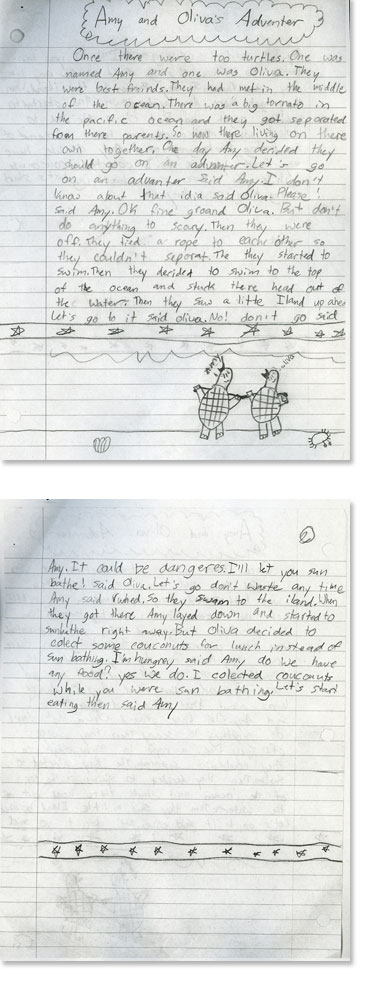Context of writing
Written by a third grade girl in a Writer’s Workshop style class where students had free choice of writing topics. These are the first two pages of a longer story that the student had not yet completed.
What is this child able to do as a writer?
- Generates an interesting idea for a story.
- Identifies interesting characters, a setting, and a problem.
- Uses precise language and begins to substitute more interesting words for overused general words such as ‘said’ (‘groaned Olivia’).
- Starts a story that flows sequentially.
- Uses dialogue in her story.
- Uses punctuation correctly — periods at the end of sentences and an exclamation point to show excitement.
- Uses apostrophes in contractions correctly.

What does this child need to learn next?
This student is using dialogue to make her story more interesting, but it is a bit confusing for the reader to follow. She is ready to learn how to use quotation marks to help clarify who is saying what in her story. The teacher could use a mini-lesson to teach a small group of students who are ready to use this skill with their dialogue (see Teaching Quotation Marks and Dialogue ). The teacher could use the books that these students are reading as the mentor texts to look for examples of quotation marks. After the students look at examples of dialogue in their own chapter books and come up with their suggestions for why authors use dialogue and what the rules are for using quotation marks, the teacher could clear up any misconceptions and challenge them to add quotation marks to their own stories.
The author is using the same transition word throughout her story to move the action forward (then). The author could learn about other transition words that help sequence a story. A list of transition words could become a part of the author’s writing notebook. Here’s a list of transition words (that might work for elementary aged students.
The sample contains examples of pronoun (there for their) and homophone (too for two, to for too). These efforts at “using but confusing” suggest that the author may be ready to study these word study features.
